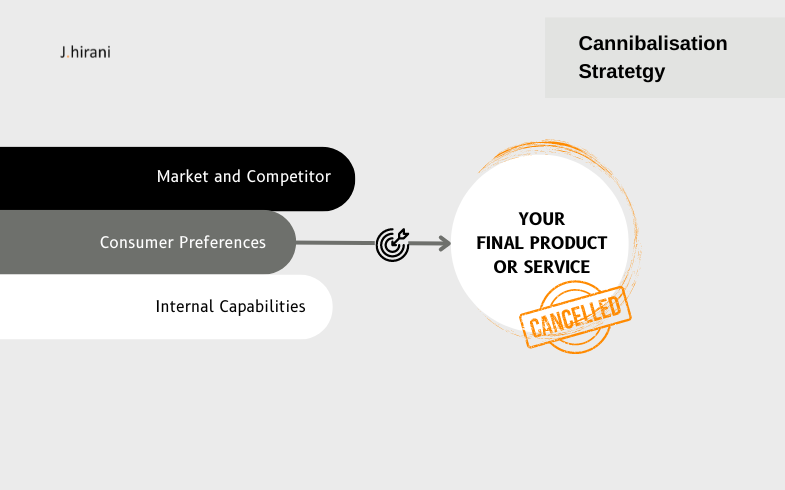Cannibalization, a powerful disruptive strategy for business growth, involves releasing new products to replace a company’s dominance in an existing market. By launching slightly better products, companies can attract new consumer segments, drawing customers away from competitors with superior offerings. This approach not only boosts spending from existing customers eager to invest in improved products but also allows companies to streamline their portfolio by phasing out non-core segments. Embracing cannibalization can lead to significant market advantages, making it a critical consideration for forward-thinking business leaders.
To fully utilize and implement this disruptive strategy, companies must understand firstly, the value their products or services bring to the market. Secondly, knowing who they are serving, influencing, and adding value to is crucial (Customer Profiling). Consumers in the same segment often experience similar shifts in sentiments, value the same things, and are influenced by the same trends in technology, personality, and job roles.
During cannibalization, companies should develop new products with the latest trends in mind, aiming to surpass their previous offerings, provide better options for existing customers, and outshine competitors. This strategy keeps teams agile and proactive. Companies must stay updated on the latest trends, competitive actions, and consumer influences. This comprehensive market, product, competitor, and customer knowledge forms the foundation for effective cannibalization.
Let’s look at some successful examples of Cannibalization
Netflix: Streaming vs. DVD Rentals:
Netflix’s shift from DVD rental service to a streaming service cannibalized its own DVD rental business. This strategic move allowed Netflix to lead the market transition towards online streaming.
Maruti Suzuki: Alto vs. Maruti 800:
The Maruti Alto gradually replaced the iconic Maruti 800, cannibalizing its sales. The Alto offered more modern features and better fuel efficiency, making it a more attractive option for budget-conscious consumers.
Hindustan Unilever Limited (HUL): Surf Excel vs. Rin:
The launch of Surf Excel Matic for washing machines affected the sales of Rin detergent, as consumers with washing machines opted for the specialised product.
Reliance Jio: JioFiber vs. Jio 4G:
The introduction of JioFiber broadband services potentially cannibalized the data usage of Jio 4G services, as customers opted for faster and more stable home internet options.
Let’s learn how Cannibalization can be used to create a culture of continuous improvement within the organization:
- Leadership Commitment and Vision: Set and communicate a clear vision emphasizing innovation and continuous improvement. Leaders should actively participate in and support initiatives that drive these goals, demonstrating their commitment to staying ahead of market trends.
- Create a Supportive Environment: Encourage calculated risk-taking and experimentation without fear of failure. Promote cross-functional collaboration to bring diverse perspectives, leading to innovative solutions and continuous improvement.
- Invest in Employee Development: Provide opportunities for continuous learning through training programs, workshops, and online courses. Offer specific training on innovation methodologies like Design Thinking, Lean Startup, and Agile to equip employees with tools for continuous improvement and innovative thinking.
- Implement Structured Processes: Establish regular feedback loops where employees can share ideas and provide input on existing products and processes, using this feedback to drive improvements. Develop clear metrics to measure the success of new products and improvements, using these benchmarks to set goals and track progress over time.
- Reward and Recognize Innovation: Create incentive programs that reward employees for innovative ideas and successful improvements through bonuses, promotions, or public recognition. Highlight and celebrate successful projects and improvements to motivate the individuals involved and inspire others to contribute to the culture of innovation.
- Encourage Product Cannibalization: Encourage teams to develop new products that may cannibalize existing ones to stay ahead of market trends and meet evolving customer needs. Invest in market research to identify emerging trends and areas where new products could potentially replace or improve upon existing offerings.
- Leverage Technology and Tools: Utilize digital platforms for idea management and collaboration, such as innovation management software, to capture, evaluate, and implement ideas across the organization. Use data analytics to gain insights into product performance and customer preferences, informing decision-making and continuous improvement efforts.
- Case Studies and Best Practices: Document and share internal case studies of successful product cannibalization and continuous improvement projects, highlighting the lessons learned and best practices. Study and share examples of other companies that have successfully implemented a culture of cannibalization and continuous improvement, adapting their strategies to your organization.
Implement this disruptive Strategy:
- Initial Assessment: Conduct an assessment to identify areas where your company can improve and innovate. Gather input from employees at all levels.
- Vision and Strategy: Define and communicate the vision and strategy for building a culture of cannibalisation and continuous improvement. Ensure alignment across the organization.
- Training and Development: Implement training programs on innovation and continuous improvement methodologies. Encourage participation across all departments.
- Pilot Projects: Launch pilot projects to test new ideas and improvements. Use these projects to demonstrate the value of the new culture and processes.
- Feedback and Iteration: Establish feedback loops to continuously gather input and iterate on projects. Use data and metrics to measure success and inform future initiatives.
- Scaling Up: Based on the success of pilot projects, scale up the initiatives and embed the culture of innovation and continuous improvement across the organization.
By following these steps, you can create a sustainable culture of cannibalization and continuous improvement, positioning your company for long-term success and market leadership.
J.hirani provides strategic advisory services to manufacturing, service brands, product brands, online/ offline business. Read our capabilities.



